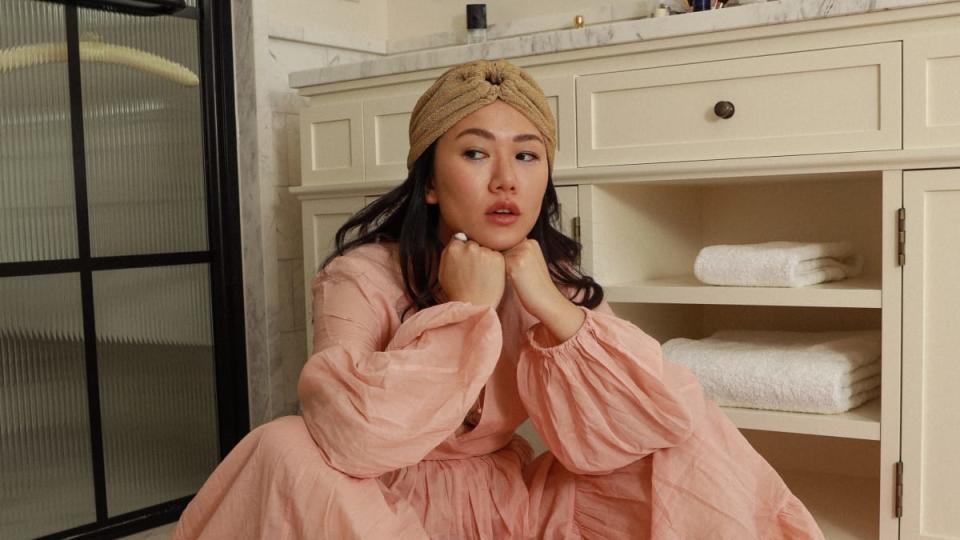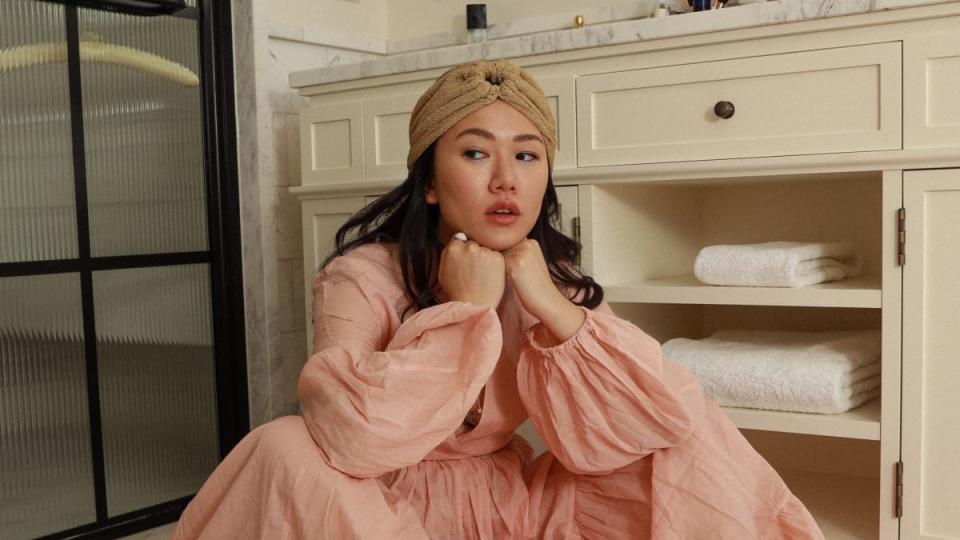How to Shop More Sustainably, According to Andrea Cheong
The viral TikTok creator shares her master class in mindful consumption, including five tips anyone can implement.
Every day, Andrea Cheong logs onto TikTok and teaches her 200,000-plus followers how to shop. Now, this is not the haul- and try-on-filled content you may have grown used to seeing sprinkled across your algorithm — no "life-changing sweaters you need to try ASAP," or "'Fleabag'-approved jumpsuits perfect for falling in doomed love with your Hot Priest." Cheong, instead, takes a more educational approach, getting down to the most elementary basics of why and how we acquire the clothing we do.
"None of us have been taught how to shop," says the London-based Cheong, a journalist by trade. "The more I started examining my clothes, I realized that, one, the quality was worse than I thought, and two, brands were making all of these claims about how their clothes were more sustainable than they actually were."
Cheong grew curiouser and curiouser about what her own wardrobe was made of — harmful and wasteful synthetics, mostly — and eventually understood why: Quality is the most underrated aspect of sustainability.
"Most people don't know how to shop for quality," she says. "We rely on brands to tell us, so we really are at the mercy of their marketing."
In 2019, Cheong took matters into her own hands, launching her own signature approach to shopping mindfully and sustainably, which she calls the Mindful Monday Method. Comprised of five parts, the practice goes beyond surface-level tasks (like learning how to analyze fabric and fibers) and asks her larger community to unpack their likely damaging relationships with money and fashion.
"There are so many people who spend all of their paycheck on clothes they know they don't need because they need new clothes to improve their lives," Cheong says. "That's what mindful consumption is about, tuning that noise out, unlearning all of these toxic shopping habits and relearning it on our terms."
We spoke with Cheong and asked her to share her most accessible steps toward a more mindful — and ultimately healthier — closet, from completing a "wardrobe audit" to becoming fluent in care labels. Read on for the highlights, in her own words.
View the original article to see embedded media.
Undergo a comprehensive wardrobe audit.
"The wardrobe audit is really for you to understand why you don't want something. You want to make a pile for donation, or pieces you don't want; a pile for alterations and repairs, or pieces you do want, but just need a little bit of TLC; and then a pile you're going to recycle.
"At this stage, you'll find there are some things that can't be recycled, and that's a lesson you need to internalize. You're going to be looking through the tags of the pieces you don't want, and you're going to realize, 'Okay, this is a synthetic blend. This can't be recycled.' It's just going to make you a lot more conscious about the waste you've accumulated. But it's not an exercise to make you feel bad — it's more of the final goodbye, coming to terms with the fact that this piece didn't serve you, it's not good quality and you can't donate it. So why did you buy it in the first place? How can you stop yourself from doing it again? We need to see it ourselves, and see the money we spent on those things."
Analyze the sometimes-ugly behavior behind your spending habits.
"This is really about addressing the links between your spending and your mental health. I'm not a financial expert, and I have no business telling you what you should or shouldn't buy with your money. For me, it's very much about finding out why you're spending what you are. One question I like to ask is, 'How old do you feel when you feel stressed about money?' Personally, I feel like a teenager. It fills me with a lot of anxiety, and it brings me back to those times where I woke up every day feeling incredibly unstable. When I feel insecure about money, I feel like I'm 15, and not in a Taylor Swift-kind of way."
Learn how to study care labels — then set boundaries.
"When you're shopping, look at the care label first. Don't even look at the size yet — just train yourself to go straight to care labels. The 'swing tag,' where you see the price, only shows you the marketing of the garment. That's the piece's headline, and you'd never claim to know the full story just reading a headline.
"Most everyday clothing doesn't need to have synthetic in it. There are so many reasons why it's added, a lot of which are commercially-driven. But in terms of buying better quality, you can start by avoiding synthetic blends. Then just take it from there. But don't get too overwhelmed: If you're at the point where you're like, 'I'm almost about to give up because this is so stressful for me,' just start with removing synthetics."
Consider quality and trendiness.
"Quality is my absolute number-one factor because it's the only thing that, as customers, we know. We'll never know the full story of supply chains. Brands don't even know that themselves. So quality is really the number-one thing we can check.
"Also, is it appropriate quality for the price point? It has to be something that you haven't felt like you were cajoled into buying just because it's a trend. Now, a trend can be a sustainable buy because if you actually think about what trends are, they're influenced by politics, innovation, tech, the economy, social movements. Micro-trends are the trends you need to be wary of because they're not always going to be representative of your style.
"A sustainable buy for you can be very different from a sustainable buy for me. I, for example, feel very strongly about synthetics, but it's entirely possible for you to decide it's appropriate for you to buy a very high-quality polyester dress. In which case, that's great for you, but it's not something I could personally recommend for me."
Identify your own realistic sustainability goals, shame-free.
"I want to impress that nobody is wrong. That's such a problem in the sustainable fashion space, that we love to say who can be sustainable and who can't.
"My goal here is to challenge you to figure out what's important to you, because if you only want to shop from independent designers or small brands, that's your way of contributing. If you never want to shop synthetics ever again, that's your way of contributing. If you never want to buy anything new, but you're fine with thrifting every weekend, that's where you're starting from. People shouldn't shame you when you're on this journey with yourself.
"A sustainable buy relies on you understanding what your sustainability goal is. I took a poll on my social media and something like 80% of people want to buy less but buy better and just be really conscious of the brands they're buying. Now, there's a very small, but vocal minority who will only shop secondhand or will only thrift or upcycle, and I think they're so noble, but, honestly, it doesn't work for everybody.
"I don't think we should rely on brands at all. But it's not that we can't believe any of them — it's more that we need to take the power back and we need to take responsibility for our purchases, and we can't do that if we don't know what we're buying."
This interview has been edited and condensed for clarity.
Never miss the latest fashion industry news. Sign up for the Fashionista daily newsletter.


